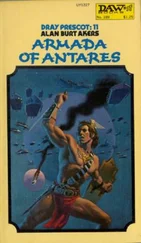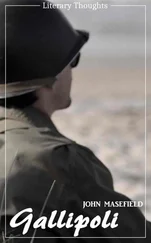The officers commanding the five new divisions were of similar cast: professional soldiers who had made their way upward mostly on the strength of their years of service. Many of them, generals and colonels alike, were men who were well over fifty and who had been in retirement when the war broke out. Major-General Hammersley, the officer who was to lead the 11th Division on the actual assault at Suvla, had suffered a breakdown a year or two before. It was a curious position; while the generals were old Regular Army soldiers, their troops were civilians and very young; and all of them, generals as well as soldiers, were wholly unused to the rough and individual kind of campaigning upon which they were now to be engaged.
Soon after he arrived at Mudros Stopford was sent over to Cape Helles for a few days to accustom himself to conditions at the front, and it was there that he was shown the plan on July 22. He was well satisfied. ‘This is the plan which I have always hoped he (Hamilton) would adopt,’ he said. ‘It is a good plan. I am sure it will succeed and I congratulate whoever has been responsible for framing it.’ But the General soon changed his mind.
On the following day he had a talk with Reed, the exponent of artillery bombardments, and on July 25 he went over to Anzac on an afternoon visit so that he could survey the Suvla plain from the slopes of Sari Bair. These experiences unsettled Stopford profoundly. On July 26 he called with Reed at G.H.Q. at Imbros and together they tore the plan to pieces. He must have more artillery, Stopford said, more howitzers to fire into the enemy trenches. It was pointed out to him that at Suvla there were no enemy trenches to speak of; Hamilton himself had been close to the shore in a destroyer and had seen no sign of life there. Samson had flown over within the last day or so and his photographs revealed nothing more than 150 yards of entrenchments between the salt lake and the sea. But Stopford remained only half convinced and Reed was quite tireless in his criticisms. Next they argued that the force should be put ashore within the bay itself. The Navy was all against this, since the water there was shallow and uncharted and no one could say what reefs or shoals might wreck the boats in the darkness. In the end, however, they agreed to land one of the three assaulting brigades inside the bay.
Still another difficulty arose over corps headquarters. Hamilton, remembering his isolation aboard the Queen Elizabeth on April 25, wanted Stopford to remain at Imbros during the early hours of the landing since he would be in touch with the troops by wireless as soon as they were ashore, and soon afterwards a telephone cable was to be laid from Imbros to the Suvla beaches. Stopford insisted that he must remain close to his troops aboard his headquarters ship, the sloop Jonquil , and in the end he had his way.
His other objections to the plan were of a vague and more subtle kind. In the original drafting it had been stated quite definitely that, since speed was. essential, the assaulting troops were to reach a series of low hills, known as Ismail Oglu Tepe, by daylight. There were good reasons for this. The interrogations of prisoners had gone to show that no more than three enemy battalions were holding the Suvla area, and the whole point of the landing was to overwhelm them and seize the high ground before the Turkish reinforcements could arrive. Since all Liman’s forces in the south of the peninsula would already be engaged at Anzac and Helles, it was believed that these reinforcements would have to be brought down from Bulair, some thirty miles away. Yet it was unwise to count on more than fifteen or twenty hours’ respite; from the moment the first Allied soldier put his foot ashore the Turks would be on the march. Everything in their bitter three months’ experience in Gallipoli had made it plain to Hamilton’s headquarters that once the period of surprise was gone there was very little chance of breaking the enemy line. Every hour, even every minute, counted.
Stopford demurred. He would do his best, he said, but there was no guarantee that he could reach the hills by daylight.
Hamilton does not appear to have pressed the point; he was content, he said, to leave it to Stopford’s own discretion as to how far he got inland in the first attack. This was a drastic watering-down of the spirit of the original plan, and it had its effect when Stopford came to pass on his instructions to his divisional commanders. The orders which General Hammersley issued to the 11th Division contained no references to speed: the brigade commanders were merely instructed to reach the hills ‘if possible’. Hammersley, indeed, seems to have gone into action in complete misunderstanding of his role in the battle; instead of regarding himself as a support to Birdwood’s main attack from Anzac he thought — and actually stated in his orders — that one of the objects of the Anzac attack was to distract the Turks from Suvla Bay while the 11th Division was getting ashore.
General Hammersley was not the only man who was in ignorance of the real objects of the offensive. An extreme secrecy was maintained by G.H.Q. at Imbros up to the very last moment.
Hamilton felt very strongly about this question of security, for he had bitter memories of the indiscretions of the Egyptian Press before the April landing. He feared the exposure of his plan by many means: by garrulous cabinet Ministers in England, by the Greek caiques that were constantly arriving in the islands from the mainland and slipping away again, by wounded officers who, on being invalided back to Egypt, might talk too freely in hospital. There was even a danger that some soldier who knew what was on foot might be captured on Gallipoli and induced by the Turks to give the show away.
In view of all this the plan was confined to a very small group at G.H.Q. throughout June and July, and Hamilton was even cautious in his letters to Kitchener. In the middle of July he sent a sharp telegram to Corps Headquarters at Anzac when he heard that Birdwood had been discussing the matter with General Godley and General Walker. ‘I am sorry you have told your divisional generals,’ he wrote. ‘I have not even informed Stopford or Bailloud (the French corps commander who had succeeded Gouraud). Please find out at once how many staff officers each of them has told, and let me know. Now take early opportunity of telling your divisional generals that whole plan is abandoned. I leave it to you to invent the reason for this abandonment. The operation is secret and must remain secret.’
Stopford himself knew nothing of the plan until three weeks before it was to be put into effect, and it was not until the last week of July that Hammersley was given his orders; Stopford took him up the coast in a destroyer to survey the intended landing places from the sea. On July 30 the brigadiers were briefed at last, and on August 3—three days before the battle was to begin — the brigadiers and their colonels were allowed a quick glimpse of the beaches from the decks of a destroyer. All other reconnaissance from the sea was forbidden lest the suspicions of the Turks should be aroused, and when finally the 11th Division embarked for the landing on August 6 many of its officers had never seen a map of Suvla Bay.
It was an excess of caution and it was not wise. Liman von Sanders says that in any case he was warned. Early in July he began to hear rumours from the islands that another landing was imminent: some 50,000 men and 140 ships were said to have been assembled at Lemnos. On July 22—the same day that Hamilton was breaking the secret to Stopford — Liman received a telegram from Supreme Headquarters in Germany. ‘From reports received here,’ it ran, ‘it seems probable that at the beginning of August a strong attack will be made on the Dardanelles, perhaps in connection with a landing on the Gulf of Saros (the Bulair area), or on the coast of Asia Minor. It will be well to economize ammunition.’
Читать дальше












